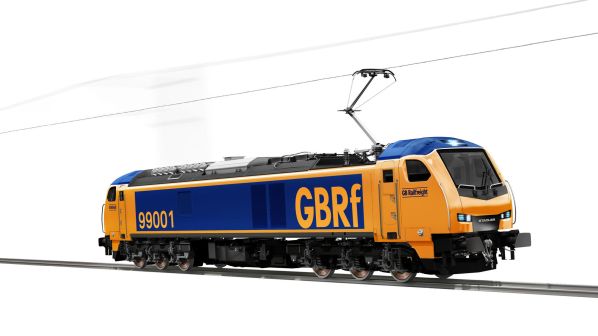Simpson sees bi-mode locomotives as the start of a UK revolution

Regardless of fuel supply, full line speed freight is the dawn of a new era for British Rail freight. Maggie Simpson, the director general of the Rail Freight Group, has welcomed the recently announced arrival of the UK version of Stadler’s Eurodual locomotive as the beginning of more than just a modal shift in motive power.
The imminent delivery of what will be designated class 99 has pleased Maggie Simpson and her audience at the recent Rail Freight Group Conference in Edinburgh. GB Railfreight has broken ranks and ordered 30 units capable of overhead electric traction and operation under their own onboard diesel power.
Investment will be transformative
As the voice of the rail freight industry in the UK, Simpson has always been generous in her praise of rail freight company investments, particularly in new facilities and equipment. The size of the order from GB Railfreight was particularly welcome since it played a part in persuading Stadler to adapt their already popular design to the unique constraints of the British loading gauge.

The thirty new bi-mode locomotives, financed in a deal with leasing agents Beacon Rail, should be capable of operating full sized intermodal trains at line speed even when using the onboard diesel engine over short distances. “This kind of investment will be transformative for decarbonising rail freight”, says Simpson. “[This] should allow a significant increase in the use of electric traction on the network, by opening up journeys which are only partly ‘under the wires’, whilst eliminating the need for locomotive changes on route.”
Lack of wires on freight routes
Speaking to a national audience at a venue next door to the Scottish parliament building, Simpson noted that the rail freight market in Scotland benefits from a much greater use of electric haulage than the average across the network in Great Britain at large. However, a large proportion of Scottish traffic is cross-border with England, where the two main routes are already electrified. “For cross border freight, however, this relies on a joined up, cross network approach that allows end to end journeys to be decarbonised. This will require capacity for growth, but as importantly, it needs the power supply to be sufficient for electrically hauled freight to operate. This is far from a given at the moment.”

Indeed, there has been some frustration at power supply issues, particularly on the East Coast Main Line out of Edinburgh. Some passenger operators have been frustrated by a lack of electrical capacity and have been forced to operate diesel power, even under the wires. Much of the freight on that route also runs with diesel power, although the lack of wires on freight routes through Edinburgh is the principal reason. Successful operations, notably by DRS (now NTS), have been routed through the city’s main station, despite demand for paths between Waverley and Haymarket. Simpson says that ahead of the Class 99 landing in the UK, there must be some good joined up work to ensure that their pantographs can be raised as often as there are wires.
Transitionary fuel whilst network is fully electrified
Government reluctance to invest in overhead line equipment is, to some extent, being restrained by developments in alternative fuel sources. Simpson says several freight operators are also looking at alternative fuels such as HVO (hydrolysed vegetable oil) as an alternative to diesel and, indeed, as an alternative to reliance on wires. “So long as they can be sustainably sourced, these fuels appear to offer significant emissions savings and will operate in diesel engines without any need for modification”, she says.
The Rail Freight Group has been actively investigating the provenance of alternative traction. The Group recently responded to a call for evidence from the UK Department for Transport, offering an informed opinion on the case for their use in the rail industry as a transitionary fuel whilst the network is not fully electrified. “There is certainly potential for the sector to make much more of these choices to further reduce their emissions, helping customers make progress on their sustainability objectives”, she said.
You just read one of our premium articles free of charge
Want full access? Take advantage of our exclusive offer





What happened to Class 93’s that are already ordered, or are the 99’s just 93’s in disguise?
Electrification now has to include a hybrid function, when ware owners have shifted strategy to On Demand and high quality, On Time, deliveries is a must.